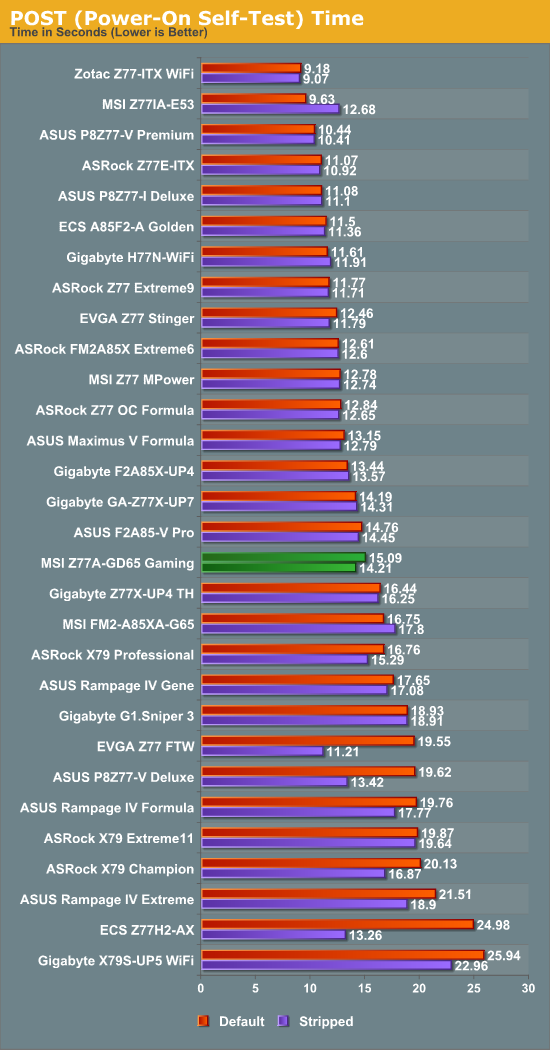MSI Z77A-GD65 Gaming Review
by Ian Cutress on April 18, 2013 12:00 PM EST- Posted in
- Motherboards
- MSI
- Z77
Many thanks to...
We must thank the following companies for kindly providing hardware for our test beds:
Thank you to OCZ for providing us with the 1250W Gold Power Supply and USB testing SSD.
Thank you to Micron for providing us with the SATA testing SSD.
Thank you to G.Skill for providing us with the memory kits.
Thank you to ASUS for providing us with the AMD GPUs and some IO Testing kit.
Thank you to ECS for providing us with the NVIDIA GPUs.
Thank you to Corsair for providing us with the Corsair H80i CLC.
Thank you to Rosewill for providing us with the 500W Platinum Power Supply for mITX testing.
Test Setup
Power Consumption
Power consumption was tested on the system as a whole with a wall meter connected to the OCZ 1250W power supply, while in a dual 7970 GPU configuration. This power supply is Gold rated, and as I am in the UK on a 230-240 V supply, leads to ~75% efficiency > 50W, and 90%+ efficiency at 250W, which is suitable for both idle and multi-GPU loading. This method of power reading allows us to compare the power management of the UEFI and the board to supply components with power under load, and includes typical PSU losses due to efficiency. These are the real world values that consumers may expect from a typical system (minus the monitor) using this motherboard.
While this method of power measurement may not be ideal, and you feel these numbers are not representative due to the high wattage power supply being used (we use the same PSU to remain consistent over a series of reviews, and the fact that some boards on our test bed get tested with three or four high powered GPUs), the important point to take away is the relationship between the numbers. These boards are all under the same conditions, and thus the differences between them should be easy to spot.

MSI motherboards have typically been good with idle power consumption, and the GD65 Gaming reflects this. Metro2033 power consumption is higher than expected, but definitely not in the realm of the high end enthusiast ranges.
Windows 7 POST Time
Different motherboards have different POST sequences before an operating system is initialized. A lot of this is dependent on the board itself, and POST boot time is determined by the controllers on board (and the sequence of how those extras are organized). As part of our testing, we are now going to look at the POST Boot Time - this is the time from pressing the ON button on the computer to when Windows starts loading. (We discount Windows loading as it is highly variable given Windows specific features.) These results are subject to human error, so please allow +/- 1 second in these results.

For whatever reason the Z77A-GD65 Gaming was not too quick with Windows 7 POST times, with over 15 seconds from power to Windows loading. I noticed that between the MSI BIOS image being shown and the Windows loading there was a period where my monitor would flicker on and off twice before focusing on the loading animation. Ideally I would like to see POST times south of 12 seconds when two GPUs are fitted.










37 Comments
View All Comments
ZoeAnderson24 - Monday, April 22, 2013 - link
before I saw the receipt for $6106, I did not believe that my friend actualy erning money in there spare time from there pretty old laptop.. there aunt has done this for only 17 months and at present paid the morgage on there villa and got themselves a Mazda. read more at, All29.comCHECK IT OUTgeokilla - Tuesday, April 23, 2013 - link
This motherboard ahs been on the market for a year and you say it's a new release...? Fail.geokilla - Tuesday, April 23, 2013 - link
Oh I missed a section. Nvmpandemonium - Tuesday, April 23, 2013 - link
Maybe it's just me, but I was expecting a lot more gaming benchmarks for a gaming MoBo.deegee - Sunday, April 28, 2013 - link
Not bad features for the price, but as mentioned in the article not much more than a stock board.Thanks, but I will stick with my ASUS ROG components.
Rob94hawk - Thursday, May 9, 2013 - link
Glad I didn't swap my blue MSI Z77A-GD65 for the gaming version. Other than the NIC and the nice color scheme it doesn't have anything to warrant a swap.PCgamerblogspot - Sunday, December 22, 2013 - link
I think you're being a little harsh on the board, MSI makes great boards and this one is no different. I own this board and although it not going to break any world records what it will do is provide a solid, stable, platform for you to build your PC off of. Its got good features and it's a (reasonably) good OC board. All in all I'm happy with it.